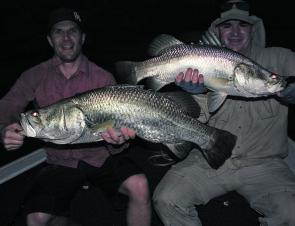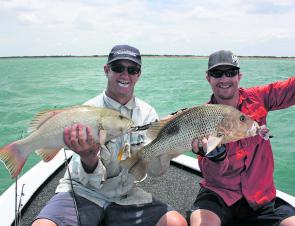The arrival of the barra season in early February also saw the arrival of the wet season big time up here on Cape York, and since then it hasn’t and doesn’t look like it will let up any time soon.
Very few have been able to put in any quality time on the barra with consistent monsoonal rain and storms coming off a strong north-westerly wind the norm for most of February. I don’t mind this and the fact I still haven’t caught my first barra for the season yet isn’t an issue as there will be plenty of time to make up for it when the wet slows and conditions improve.
It’s no secret and no surprise that the year and years to follow a good wet produce some of the best fishing. The lay of the land all through northern Australia indicates that there needs to be big rain and floods to get into and refresh the waterways, billabongs, creeks and rivers, both big and small. Most of the Gulf has now seen some serious rain with some areas recording record falls. Kowanyama, a small community to the south of Weipa, saw falls exceeding 1100mm during the first week of February! That is some serious rain and by all reports there is more to come.
On the fishing front locally most reports have indicated patchy fishing, which really is the norm for this time of year, the deep holes at the mouths of Weipa’s major rivers have seen some great catches of both black jew and grunter, however they have been there one day and gone the next. These deeper holes can really only be fished on the turn of the tide and during the run in this time of year as on the run out the fresh pushing down the rivers makes for holding a bait on the bottom an impossibility.
Banks and drop offs adjacent to these holes however, can fish well during these times of big run. Best baits by far are fresh slabs of mullet, herring or other baitfish and freshly caught live and dead prawns. This is the time of year to fire up the cast net around the river mouths and get a haul of prawns for a feed or for bait before they head out wider and into the Gulf. This time of year, with bait hard to find and the fish not overly fussy, means a nice chunk of squid can be as good as anything with more time spent with a bait in the water the way to go.
Any more than a few kilometres up the rivers now is pure fresh water so once up in these areas it’s barra that are the target. Clear drains and creeks running into the main river are what you want to look out for and each one needs to be worked properly with a selection of lures and plastics to entice any in the area. For some reason it’s usually one drain in the area that will hold most of the fish and obviously this is the one that needs to be found. This hot spot can change from trip to trip however as water levels and conditions change and you will soon work out that the fish aren’t always hanging in the same spot they where they were last trip.
A small window of better weather during February saw a few boats head offshore to tangle with the reefies, and while the conditions seemed ok, things obviously hadn’t settled right down as the real quality proved hard to find. Moving around and working hard was the only real solution and if you used this as a plan of attack there was no problem in picking up a feed of tuskies, fingermark and cod.
By mid March we should see the wet season ease and the fishing options and catches pick up. Most species should start to haunt their usual run off spots and be found with more consistency. The run of grunter should be found at all their usual land-based haunts at the river mouths, while barra, jacks and fingermark will really start to fire up as the rivers clear.
Offshore, when the westerly swell drops, some nice fish should be on the chew and when the water clears for a week or more the pelagics should start to show. Big bait schools in Albatross Bay are an indicator conditions have improved and the Spaniards, queenies and trevally will be on the prowl. Some miles may need to be done however to find some of this action. Be careful of huge floating logs when travelling as there will be plenty out there after what looks to have the makings of a ripper Wet.
Reads: 1191
Barra are about, but they’ll take some finding with the brilliant wet we have had.

Offshore the fishing is a bit sporadic, however with more settled weather fingermark and coral trout like these rippers will be easier to locate.




